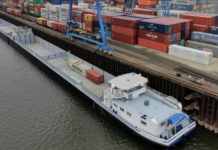
In line with its ambitious target of achieving net zero emissions across its controlled terminals globally by 2040 and a 70% total emission reduction by 2030, one of the major pillars of APM’s decarbonisation strategy is the electrification of its assets, radically reducing its consumption of fossil fuels across terminals.
However, it is not just about switching from diesel-fuelled equipment to using the one that runs on electricity, but also about making a conscious choice to only source green or emission-free electricity, therefore reducing Scope 2 emissions, that is, emissions resulting from the production of electricity needed to power electric terminal equipment. The definition of “renewable electricity” is quite simple: it is the electricity that is generated by using, for example, hydropower, wind, or solar energy.
After switching to green electricity in APM Terminals in Aarhus, Denmark, at the beginning of 2022, APM has now achieved an important milestone, with all electric operations at APM Terminals’ European facilities being powered by green electricity. As a result of its latest round of switches, the overall emission reduction is 52 kilotons of CO2, which equals 9% of APM Terminals’ overall Emissions versus its baseline year of 2020. These reductions and the sources of procured electricity are all certified by PwC.
Outside of Europe, APM also has major achievements in terms of switching to green electricity. For example, APM Terminals Pipavav in India signed a contract to procure 40% of its electricity demand from wind and solar energy sources via an Offsite Power Purchase Agreement with Cleanmax, reducing the Scope 2 emissions by 3400 tCO2 (out of a total of 8500 tCO2). It has also commissioned a solar PV installation of 1 MW, which will provide 14MWh per year and reduce emissions by a further 1040 tons of CO2. With these initiatives, APM Terminals Pipavav is now one of India’s lowest emitting terminal operators.
In the terminals industry, electrification is one of the most effective levers to reduce emissions. However, it’s vital to ensure this happens transparently by purchasing electricity that truly comes from renewable sources – otherwise, it is just “pollution in disguise”.
อัพเดตข่าวสารและบทความที่น่าสนใจในอุตสาหกรรมโลจิสติกส์ก่อนใคร ผ่าน Line Official Account @Logistics Mananger เพียงเพิ่มเราเป็นเพื่อน @Logistics Manager หรือคลิกที่นี่















